Xiao Feng
Tibetan Language and AI: A Comprehensive Survey of Resources, Methods and Challenges
Oct 22, 2025Abstract:Tibetan, one of the major low-resource languages in Asia, presents unique linguistic and sociocultural characteristics that pose both challenges and opportunities for AI research. Despite increasing interest in developing AI systems for underrepresented languages, Tibetan has received limited attention due to a lack of accessible data resources, standardized benchmarks, and dedicated tools. This paper provides a comprehensive survey of the current state of Tibetan AI in the AI domain, covering textual and speech data resources, NLP tasks, machine translation, speech recognition, and recent developments in LLMs. We systematically categorize existing datasets and tools, evaluate methods used across different tasks, and compare performance where possible. We also identify persistent bottlenecks such as data sparsity, orthographic variation, and the lack of unified evaluation metrics. Additionally, we discuss the potential of cross-lingual transfer, multi-modal learning, and community-driven resource creation. This survey aims to serve as a foundational reference for future work on Tibetan AI research and encourages collaborative efforts to build an inclusive and sustainable AI ecosystem for low-resource languages.
RLMR: Reinforcement Learning with Mixed Rewards for Creative Writing
Aug 28, 2025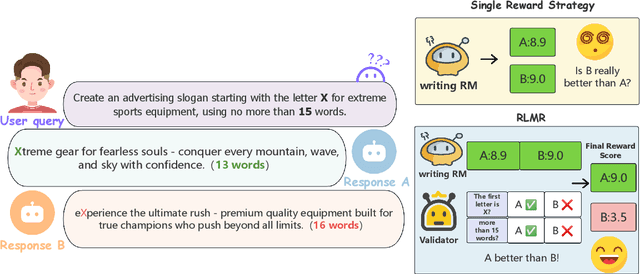
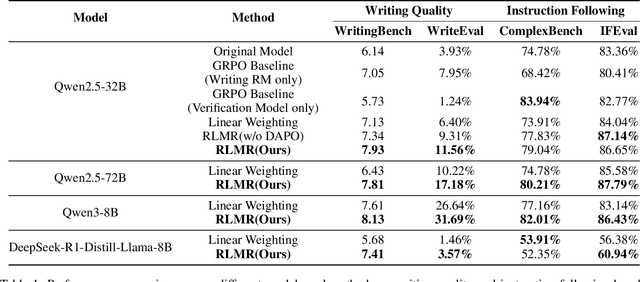
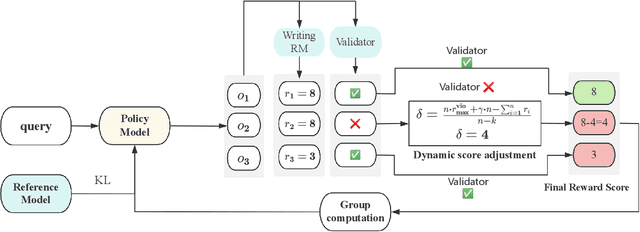
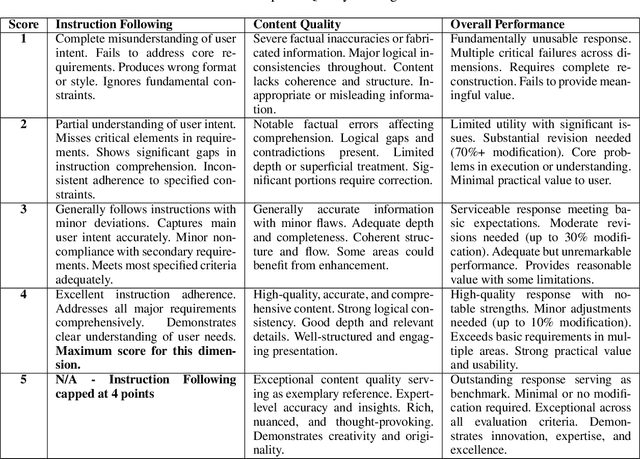
Abstract:Large language models are extensively utilized in creative writing applications. Creative writing requires a balance between subjective writing quality (e.g., literariness and emotional expression) and objective constraint following (e.g., format requirements and word limits). Existing methods find it difficult to balance these two aspects: single reward strategies fail to improve both abilities simultaneously, while fixed-weight mixed-reward methods lack the ability to adapt to different writing scenarios. To address this problem, we propose Reinforcement Learning with Mixed Rewards (RLMR), utilizing a dynamically mixed reward system from a writing reward model evaluating subjective writing quality and a constraint verification model assessing objective constraint following. The constraint following reward weight is adjusted dynamically according to the writing quality within sampled groups, ensuring that samples violating constraints get negative advantage in GRPO and thus penalized during training, which is the key innovation of this proposed method. We conduct automated and manual evaluations across diverse model families from 8B to 72B parameters. Additionally, we construct a real-world writing benchmark named WriteEval for comprehensive evaluation. Results illustrate that our method achieves consistent improvements in both instruction following (IFEval from 83.36% to 86.65%) and writing quality (72.75% win rate in manual expert pairwise evaluations on WriteEval). To the best of our knowledge, RLMR is the first work to combine subjective preferences with objective verification in online RL training, providing an effective solution for multi-dimensional creative writing optimization.
From Passive to Active Reasoning: Can Large Language Models Ask the Right Questions under Incomplete Information?
Jun 09, 2025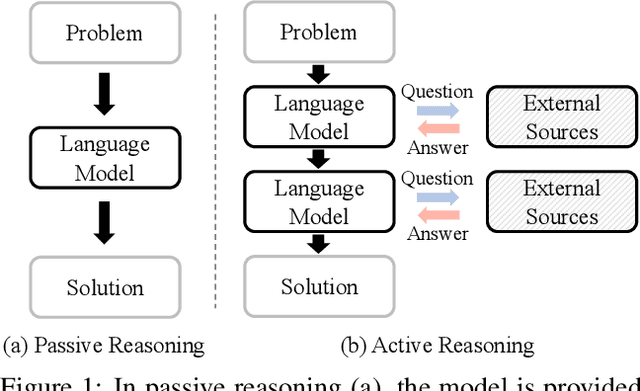
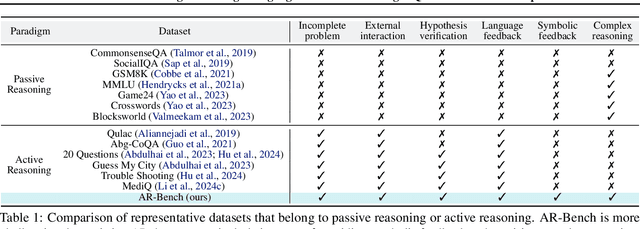


Abstract:While existing benchmarks probe the reasoning abilities of large language models (LLMs) across diverse domains, they predominantly assess passive reasoning, providing models with all the information needed to reach a solution. By contrast, active reasoning-where an LLM must interact with external systems to acquire missing evidence or data-has received little systematic attention. To address this shortfall, we present AR-Bench, a novel benchmark designed explicitly to evaluate an LLM's active reasoning skills. AR-Bench comprises three task families-detective cases, situation puzzles, and guessing numbers-that together simulate real-world, agentic scenarios and measure performance across commonsense, logical, and symbolic reasoning challenges. Empirical evaluation on AR-Bench demonstrates that contemporary LLMs exhibit pronounced difficulties with active reasoning: they frequently fail to acquire or leverage the information needed to solve tasks. This gap highlights a stark divergence between their passive and active reasoning abilities. Moreover, ablation studies indicate that even advanced strategies, such as tree-based searching or post-training approaches, yield only modest gains and fall short of the levels required for real-world deployment. Collectively, these findings highlight the critical need to advance methodology for active reasoning, e.g., incorporating interactive learning, real-time feedback loops, and environment-aware objectives for training. The benchmark is publicly available at: https://github.com/tmlr-group/AR-Bench.
$C^3$-Bench: The Things Real Disturbing LLM based Agent in Multi-Tasking
May 24, 2025Abstract:Agents based on large language models leverage tools to modify environments, revolutionizing how AI interacts with the physical world. Unlike traditional NLP tasks that rely solely on historical dialogue for responses, these agents must consider more complex factors, such as inter-tool relationships, environmental feedback and previous decisions, when making choices. Current research typically evaluates agents via multi-turn dialogues. However, it overlooks the influence of these critical factors on agent behavior. To bridge this gap, we present an open-source and high-quality benchmark $C^3$-Bench. This benchmark integrates attack concepts and applies univariate analysis to pinpoint key elements affecting agent robustness. In concrete, we design three challenges: navigate complex tool relationships, handle critical hidden information and manage dynamic decision paths. Complementing these challenges, we introduce fine-grained metrics, innovative data collection algorithms and reproducible evaluation methods. Extensive experiments are conducted on 49 mainstream agents, encompassing general fast-thinking, slow-thinking and domain-specific models. We observe that agents have significant shortcomings in handling tool dependencies, long context information dependencies and frequent policy-type switching. In essence, $C^3$-Bench aims to expose model vulnerabilities through these challenges and drive research into the interpretability of agent performance. The benchmark is publicly available at https://github.com/yupeijei1997/C3-Bench.
Hunyuan-TurboS: Advancing Large Language Models through Mamba-Transformer Synergy and Adaptive Chain-of-Thought
May 21, 2025Abstract:As Large Language Models (LLMs) rapidly advance, we introduce Hunyuan-TurboS, a novel large hybrid Transformer-Mamba Mixture of Experts (MoE) model. It synergistically combines Mamba's long-sequence processing efficiency with Transformer's superior contextual understanding. Hunyuan-TurboS features an adaptive long-short chain-of-thought (CoT) mechanism, dynamically switching between rapid responses for simple queries and deep "thinking" modes for complex problems, optimizing computational resources. Architecturally, this 56B activated (560B total) parameter model employs 128 layers (Mamba2, Attention, FFN) with an innovative AMF/MF block pattern. Faster Mamba2 ensures linear complexity, Grouped-Query Attention minimizes KV cache, and FFNs use an MoE structure. Pre-trained on 16T high-quality tokens, it supports a 256K context length and is the first industry-deployed large-scale Mamba model. Our comprehensive post-training strategy enhances capabilities via Supervised Fine-Tuning (3M instructions), a novel Adaptive Long-short CoT Fusion method, Multi-round Deliberation Learning for iterative improvement, and a two-stage Large-scale Reinforcement Learning process targeting STEM and general instruction-following. Evaluations show strong performance: overall top 7 rank on LMSYS Chatbot Arena with a score of 1356, outperforming leading models like Gemini-2.0-Flash-001 (1352) and o4-mini-2025-04-16 (1345). TurboS also achieves an average of 77.9% across 23 automated benchmarks. Hunyuan-TurboS balances high performance and efficiency, offering substantial capabilities at lower inference costs than many reasoning models, establishing a new paradigm for efficient large-scale pre-trained models.
Multi-Mission Tool Bench: Assessing the Robustness of LLM based Agents through Related and Dynamic Missions
Apr 03, 2025Abstract:Large language models (LLMs) demonstrate strong potential as agents for tool invocation due to their advanced comprehension and planning capabilities. Users increasingly rely on LLM-based agents to solve complex missions through iterative interactions. However, existing benchmarks predominantly access agents in single-mission scenarios, failing to capture real-world complexity. To bridge this gap, we propose the Multi-Mission Tool Bench. In the benchmark, each test case comprises multiple interrelated missions. This design requires agents to dynamically adapt to evolving demands. Moreover, the proposed benchmark explores all possible mission-switching patterns within a fixed mission number. Specifically, we propose a multi-agent data generation framework to construct the benchmark. We also propose a novel method to evaluate the accuracy and efficiency of agent decisions with dynamic decision trees. Experiments on diverse open-source and closed-source LLMs reveal critical factors influencing agent robustness and provide actionable insights to the tool invocation society.
Landscape of Thoughts: Visualizing the Reasoning Process of Large Language Models
Mar 28, 2025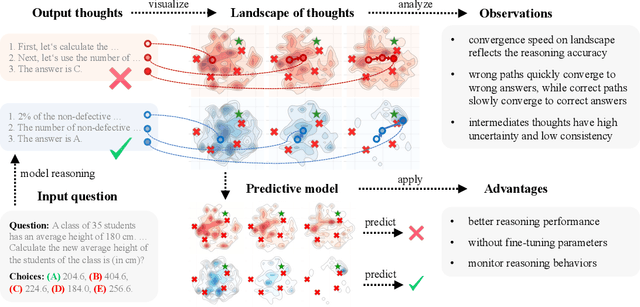
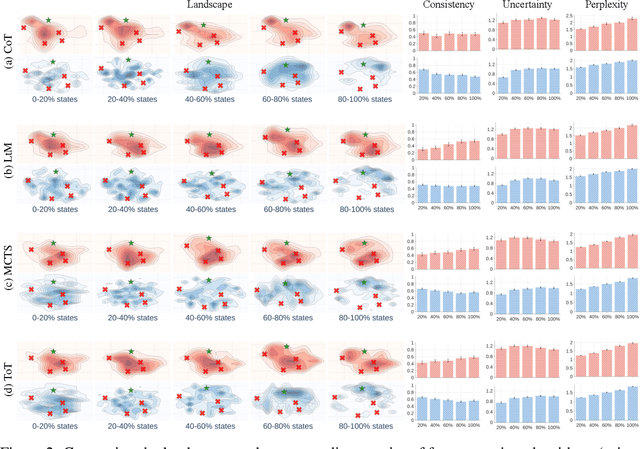
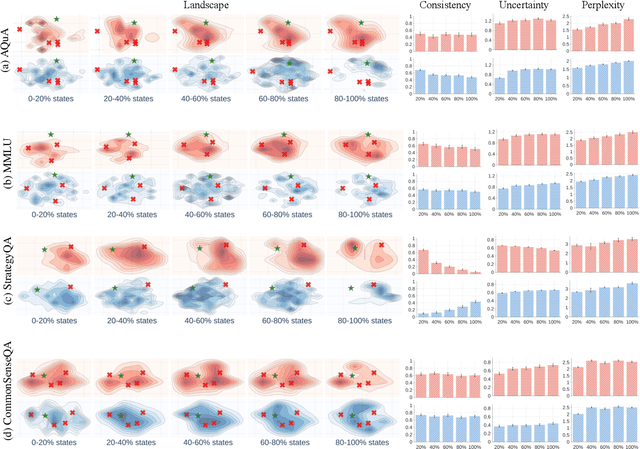
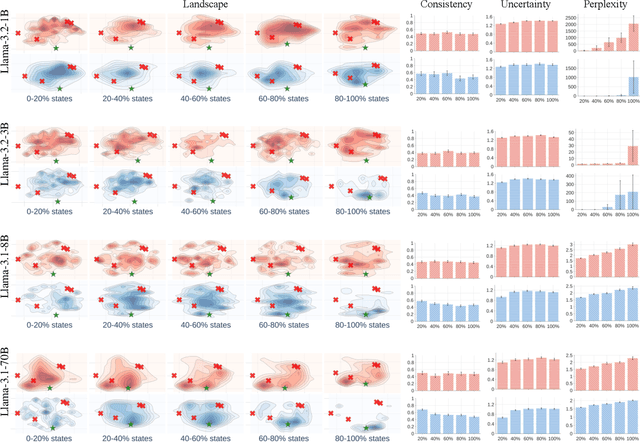
Abstract:Numerous applications of large language models (LLMs) rely on their ability to perform step-by-step reasoning. However, the reasoning behavior of LLMs remains poorly understood, posing challenges to research, development, and safety. To address this gap, we introduce landscape of thoughts-the first visualization tool for users to inspect the reasoning paths of chain-of-thought and its derivatives on any multi-choice dataset. Specifically, we represent the states in a reasoning path as feature vectors that quantify their distances to all answer choices. These features are then visualized in two-dimensional plots using t-SNE. Qualitative and quantitative analysis with the landscape of thoughts effectively distinguishes between strong and weak models, correct and incorrect answers, as well as different reasoning tasks. It also uncovers undesirable reasoning patterns, such as low consistency and high uncertainty. Additionally, users can adapt our tool to a model that predicts the property they observe. We showcase this advantage by adapting our tool to a lightweight verifier that evaluates the correctness of reasoning paths. The code is publicly available at: https://github.com/tmlr-group/landscape-of-thoughts.
TLUE: A Tibetan Language Understanding Evaluation Benchmark
Mar 15, 2025

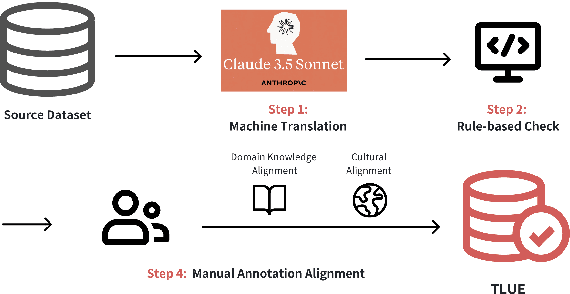

Abstract:Large language models (LLMs) have made tremendous progress in recent years, but low-resource languages, such as Tibetan, remain significantly underrepresented in their evaluation. Despite Tibetan being spoken by over seven million people, it has largely been neglected in the development and assessment of LLMs. To address this gap, we present TLUE (A Tibetan Language Understanding Evaluation Benchmark), the first large-scale benchmark for assessing LLMs' capabilities in Tibetan. TLUE comprises two major components: (1) a comprehensive multi-task understanding benchmark spanning 5 domains and 67 subdomains, and (2) a safety benchmark covering 7 subdomains. We evaluate a diverse set of state-of-the-art LLMs. Experimental results demonstrate that most LLMs perform below the random baseline, highlighting the considerable challenges LLMs face in processing Tibetan, a low-resource language. TLUE provides an essential foundation for driving future research and progress in Tibetan language understanding and underscores the need for greater inclusivity in LLM development.
Hunyuan-Large: An Open-Source MoE Model with 52 Billion Activated Parameters by Tencent
Nov 05, 2024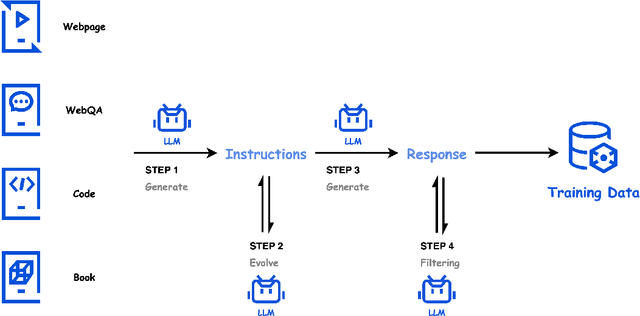
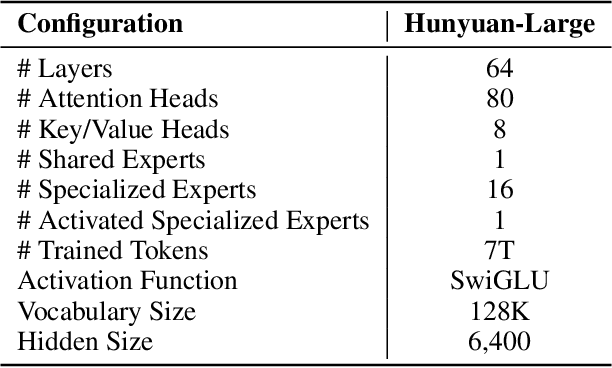
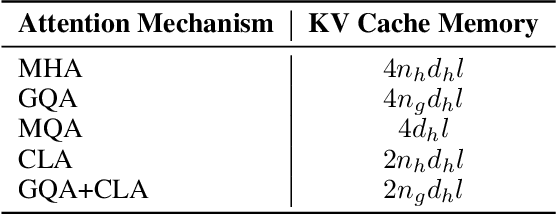
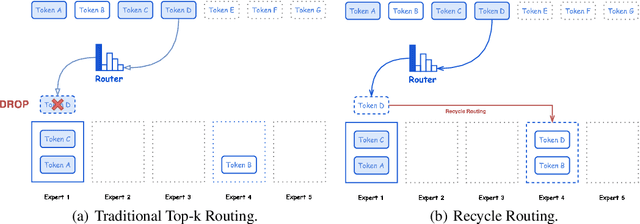
Abstract:In this paper, we introduce Hunyuan-Large, which is currently the largest open-source Transformer-based mixture of experts model, with a total of 389 billion parameters and 52 billion activation parameters, capable of handling up to 256K tokens. We conduct a thorough evaluation of Hunyuan-Large's superior performance across various benchmarks including language understanding and generation, logical reasoning, mathematical problem-solving, coding, long-context, and aggregated tasks, where it outperforms LLama3.1-70B and exhibits comparable performance when compared to the significantly larger LLama3.1-405B model. Key practice of Hunyuan-Large include large-scale synthetic data that is orders larger than in previous literature, a mixed expert routing strategy, a key-value cache compression technique, and an expert-specific learning rate strategy. Additionally, we also investigate the scaling laws and learning rate schedule of mixture of experts models, providing valuable insights and guidances for future model development and optimization. The code and checkpoints of Hunyuan-Large are released to facilitate future innovations and applications. Codes: https://github.com/Tencent/Hunyuan-Large Models: https://huggingface.co/tencent/Tencent-Hunyuan-Large
CoMo: A novel co-moving 3D camera system
Jan 26, 2021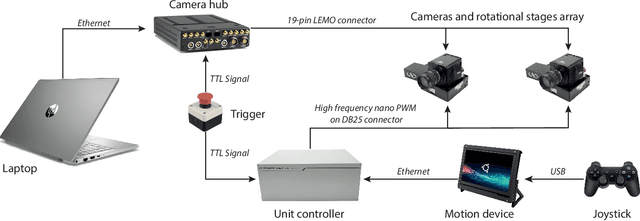
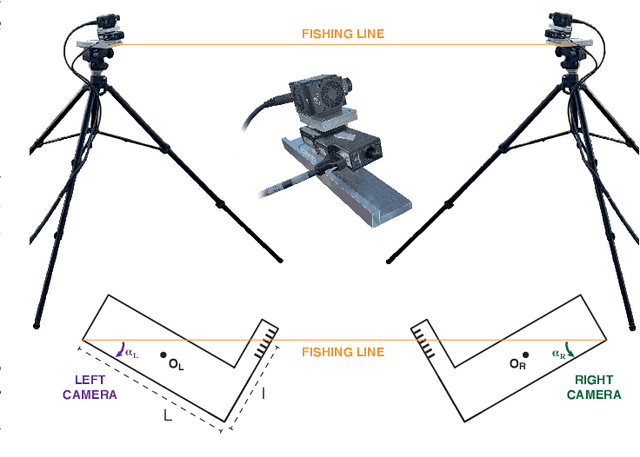
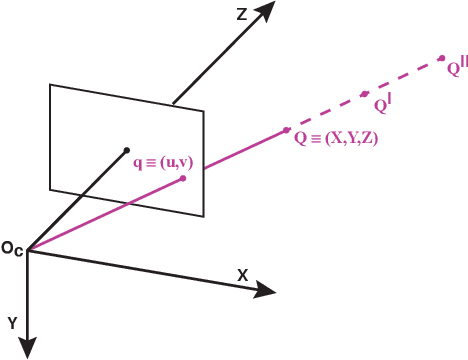
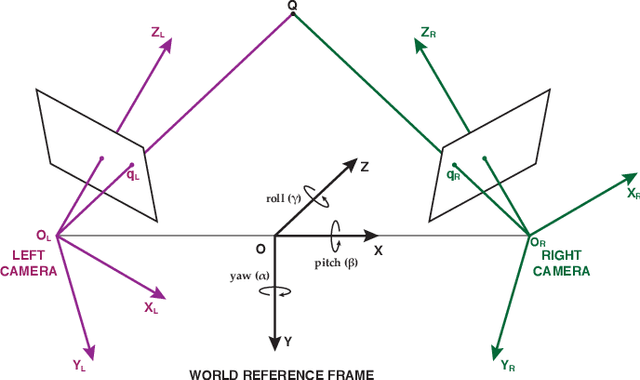
Abstract:Motivated by the theoretical interest in reconstructing long 3D trajectories of individual birds in large flocks, we developed CoMo, a co-moving camera system of two synchronized high speed cameras coupled with rotational stages, which allow us to dynamically follow the motion of a target flock. With the rotation of the cameras we overcome the limitations of standard static systems that restrict the duration of the collected data to the short interval of time in which targets are in the cameras common field of view, but at the same time we change in time the external parameters of the system, which have then to be calibrated frame-by-frame. We address the calibration of the external parameters measuring the position of the cameras and their three angles of yaw, pitch and roll in the system "home" configuration (rotational stage at an angle equal to 0deg and combining this static information with the time dependent rotation due to the stages. We evaluate the robustness and accuracy of the system by comparing reconstructed and measured 3D distances in what we call 3D tests, which show a relative error of the order of 1%. The novelty of the work presented in this paper is not only on the system itself, but also on the approach we use in the tests, which we show to be a very powerful tool in detecting and fixing calibration inaccuracies and that, for this reason, may be relevant for a broad audience.
 Add to Chrome
Add to Chrome Add to Firefox
Add to Firefox Add to Edge
Add to Edge